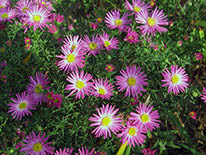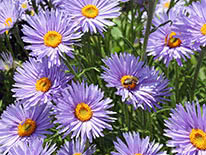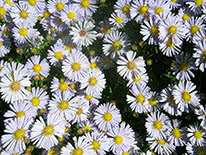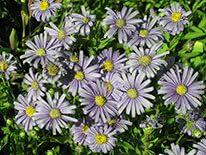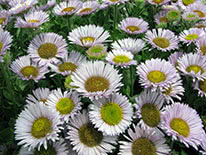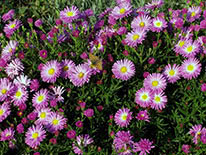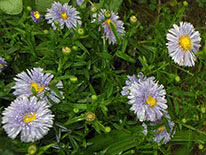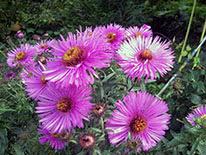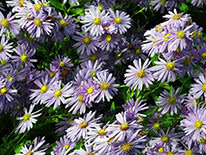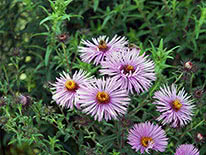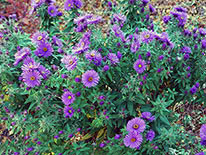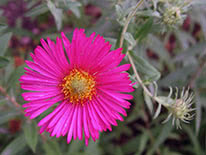Aster: growing from seeds, planting, care, varieties
Autumn in the shady park...The gold of
Maple leaves is on the water pond.
The leaves are twirling ... The birds are silent ...
At the cold sky
Aster looks, radiant aster-star
 Aster (лат. Aster) is a genus of annual and perennial herbaceous plants in the family Asteraceae, or family Compositae, including from 200 to 500 species according to various sources, most of which grow in North and Central America. In Europe, the aster flower was secretly brought from China by a French monk in the 17th century. The flower’s name comes from the Latin word “aster” meaning “star”. There is a Chinese legend about two monks that tried to reach the stars climbing the highest mountain of Altai for many days, but when they reached the summit, the stars above them were still far away and inaccessible. Then being disappointed, without food and water, after spending so many difficult days on the road, they returned to the foot of the mountain and saw a wonderful meadow with beautiful flowers.
Aster (лат. Aster) is a genus of annual and perennial herbaceous plants in the family Asteraceae, or family Compositae, including from 200 to 500 species according to various sources, most of which grow in North and Central America. In Europe, the aster flower was secretly brought from China by a French monk in the 17th century. The flower’s name comes from the Latin word “aster” meaning “star”. There is a Chinese legend about two monks that tried to reach the stars climbing the highest mountain of Altai for many days, but when they reached the summit, the stars above them were still far away and inaccessible. Then being disappointed, without food and water, after spending so many difficult days on the road, they returned to the foot of the mountain and saw a wonderful meadow with beautiful flowers.
One of the monks said: “Look! We were looking for stars in the sky, but they live on the Earth!" The monks dug up a few flowers, brought them to their monastery, began to grow them and gave them the star name “asters”. Since ancient times in China asters have become a symbol of beauty, elegance, modesty and charm. Aster is a flower born under the sign of the Virgin, the symbol of the dream of the unknown, the gift of God to man, his guardian, his guiding star...
Aster flower – description
Asters are rhizomatous plants with simple leaves, the inflorescences are heads, collected in panicles or corymbs, ray florets come in all possible shades, and disk florets are small, almost always yellow in color. Aster flower has been cultivated in Europe since the 17th century, and flower growers have succeeded in breeding of amazingly beautiful varieties, among them there are flowers of all color and shape variations. Aster is propagated by seeds. Depending on the type of inflorescences and the height of the stem, asters are used as bordering plants, for landscape designs, flower and rock gardens, or as decorations for balconies and terraces. Bouquets of cut asters are very beautiful and last long in a vase.
Species and varieties of asters
Aster with its straight petals
Has been called “star” since ancient times.
So you would call it yourself.
Its petals radiate
From the golden core.
What aster
There is one problem: when we talk about asters, we need to understand what is meant. There is a genus of asters, to which both annual and perennial species and varieties belong and we have mentioned them above, but there is a China aster that amateur gardeners take for annual aster, however in fact they are different plants. Annual aster, or Callistephus (lat. Callistephus) – is a Chinese monotypic genus of flowering plants in the family Asteraceae, close to the genus of Aster. Callistephus is an annual or biennial plant, in flower cultivation it is called “China aster” referring to its motherland. In 1825, the only representative of the genus was described by Carl Linnaeus who named it Aster chinensis. Alexandre H. de Cassini placed it in a separate genus and renamed it into Callistephus chinensis.
The stems of the plant are green, sometimes dark red, branched or simple. The root system is fibrous, powerful, well branched. The leaves are alternate, petiolate; the inflorescences are flower heads, the fruit is cypsela. In cultivation there are about 40 groups that include about 4,000 varieties. This is the relative of aster we usually deal with when planting annual asters in the gardens.
Perennial asters
Perennials of the aster genus are divided into two groups according to the terms of flowering: early-flowering and autumn-flowering.
Early-flowering perennial asters
The early-flowering group is not very numerous and represented only by such species as alpine aster (Aster alpinus), European Michaelmas-daisy, or Italian aster (Aster bessarabicus, Aster amellus).
Alpine aster
It is a perennial aster from the Alpine group blooming in May. It is from 6 to 12 inches high. The inflorescences are single up to 2 inches in diameter, look like simple daisies, and are often used for rock gardens. The varieties are:
- Alpine aster Glory is 10 inches in height, flower diameter is 1.6 inches, it is blue daisy with yellow-orange center;
- aster Wargrave has the height up to 12 inches, the diameter of a pink flower with a yellow center is 1.6 inches, it blooms in May-June
Italian aster
It is also called European Michaelmas-daisy. It blooms in June-July. Its inflorescences are large, up to 2 inches in diameter, the flower heads are corymbose inflorescences, the shrubs are up to 2.3 ft high. It is great for stone gardens. The varieties are:
- Aster Rosea has pink ray florets and light brown disk florets. It blooms for up to three months from June;
- Rudolf Goeth has large shield inflorescences up to 1.6-2 inches in diameter, ray florets are purple, disk florets are yellow;
Autumn-flowering perennial asters
Autumn-flowering asters are represented more diversely: New York aster, bushy aster and New England aster.
Bushy aster
Bushy aster (aster dumosus) is the first to bloom in autumn, native to North America. The varieties of this species are from 8 to 24 inches high, the stems are so leafy that even when they do not bloom, they are still able to decorate the garden like boxtrees. The most famous varieties are:
- Niobe and Alba Flora Plena are asters with white flowers;
- Blue Bird is a dwarf variety up to 10 inches tall with soft blue flowers, like taller Blue Bouquet and Lady in Blue;
New York aster
The most common asters in our gardens are New York asters (Aster novi-belgii) having both dwarf varieties (12-16 inches) and tall ones ( up to 4.6 ft). Bushes of this species are vigorous, inflorescence are paniculate, flowers come in blue, white, purple colors and in all shades of pink and burgundy. The varieties are:
- dwarf varieties: Snowsprite is with white flowers, 1.1 ft high; Jenny has red asters, up to 12 inches high; Audrey has pink flowers, up to 1.5 ft high;
- medium-sized varieties: blue-violet Royal Velvet up to 2 ft tall; Winston S. Churchill has rich ruby shrubs 2.3-2.5 ft high;
- tall varieties: Dusty Rose is a bush up to 3.3 ft high with delicate raspberry flowers up to 1.6 inches in diameter; Desert blues has lilac-blue flowers up to 1.4 inches in diameter, the bushes are up to 3.3 ft high.
New England aster (Aster novae-angliae)
Also known as hairy Michaelmas daisy, it is popular species in autumn gardens. It differs from other perennial asters by the height of the bushes that reach 5.2 ft. In all other respects it resembles New York aster having very profuse flowering of small inflorescences. The varieties are:
- Browmann is a shrub up to 4 ft tall, the diameter of racemose inflorescences is up to 1.6 inches, and it blooms profusely from September. Ray florets are violet;
- Constance reaches 6 ft in height, the stems are branched, powerful. The inflorescences are up to 1.4 inches in diameter, disk florets are brown or yellow, ray florets are purple. Its flowering lasts from September till frosts;
- September ruby is 5 ft high, ray florets are red-pink, the inflorescence has a diameter of 1.4 inches.
Annual asters
China aster, or Callistephus is an annual relative of perennial aster. Today it is represented by more than 4,000 varieties. Sometimes annual aster are so unlike the true asters that they can be confused with dahlias, chrysanthemums, peonies and other flowers. Trying to put in order this incredible array of varieties and species, scientists have created several classifications, but none of them is perfect. We will list some of them.
By the term of flowering asters are divided into:
- early-flowering (starts in July);
- mid-flowering (bloom at the beginning of August);
- late-flowering (bloom from the middle or end of August).
By the height of the bushes asters are divided into five groups:
- dwarf (up to 10 inches);
- low-growing (up to 14 inches);
- mid-growing (up to 2 ft);
- tall (up to 2.6 ft);
- giant (more than 2.6 ft);
By the purpose of cultivation aster is classified into three groups:
- cutting (tall stems, large flowers, long peduncles);
- bordering (compact, low-growing, good for growing in flower beds and as well as in the pots);
- universal (compact, mid-sized, with long peduncles and large inflorescences).
According to the structure of the inflorescences, asters are divided into three groups:
- disk flowers have the inflorescences consisting only of disk florets;
- transitional flowers have the inflorescences consisting of 1-2 rows of ray florets and disk florets in the center;
- ray flowers have the inflorescences, in which ray florets cover disk florets or there are no disk florets at all.
The ray group is divided according to the structure of the inflorescence into the following types:
simple:
- Edelweiss, Pinocchio, Waldersee are varieties with small inflorescences;
- Salome is a variety with mid-sized inflorescences;
- Rainbow, Margarita are varieties with large inflorescences;
- Madeleine, Sonenstein are varieties with very large inflorescences.
crown form:
- Ariake, Tikuma have small inflorescences;
- Aurora, Prinetta, Laplata are mid-sized;
- Princess, anemone aster, Ramona are large;
- Erfordia, Princess Giant, Fantasy are very large.
semi-double:
- small: Victoria, Matsumoto;
- mid-sized: Mignon, Rosette.
curly:
- Comet, Tiger paws have mid-sized inflorescences;
- Ostrich feather, Queen of the market are large;
- Mum-like aster, California aster.
ball-like (spherical):
- Milady, Lido, Triumph are with mid-sized inflorescences;
- American beauty, Germany, peony-like aster have large inflorescences;
- Ball-like asters have very large inflorescences.
imbricated:
- Voronezh, Victoria, Tausendschon have mid-sized inflorescences.
needle:
- Record, Exotics have mid-sized inflorescences;
- Riviera, Star have large inflorescences;
- Compliment, Riesen, Jubilee have very large inflorescences.
hemispherical:
- mid-sized inflorescences: Miss, Amor, Rose-like;
- Pompon aster have large inflorescences.
But there is no classification by the flower color, although there are a lot of colors and shades of asters: different shades of blue, that are very rare in the flower world, purple, lilac, cream, yellow, pink, red, white. There are bi-colored asters. There are no green and orange asters yet.
It should be noted that none of the classifications is complete and perfect, especially since every year breeders create new specimens that are difficult to relate to already existing species and variety groups.
Growing of asters from seeds
Seeds of asters
Growing of asters from seeds is carried out in seedling and non-seedling way. Early varieties of aster are sown in the soil at the beginning or in the middle of March, and then in July you will already be able to admire their bloom. Late varieties are sown in late April-early May, when the air temperature is at least 50°F. But you should note that asters grown from seeds in a non-seedling way start blooming later than those that were grown in a greenhouse. Sowing of asters is carried out in shallow furrows (up to 1.6 inches deep). They are generously watered, covered with the soil, and when the weather is dry the the soil is mulched, or cover the planting site with garden cloth until sprouts appear. Then the garden cloth is used only in case of frost. When the seedlings have two or three true leaves, the seedlings are thinned so that the distance between the shoots is 4-6 inches. The remaining seedlings are transplanted into another place.

When to sow asters
Early varieties of asters start blooming 90 days after planting, mid-season varieties start blooming in 110 days (early August), late varieties bloom in 120-130 days (late August-mid-September). That is, before sowing of astra, you need to make simple calculations. Late varieties of asters can bloom till the frosts. Asters can be sown not only in spring, but also in the late autumn, before winter, directly into the furrows with the frozen soil – in this case the plants are almost insusceptible to fusarium wilt. When the shoots appear in spring, thin them out. By the way, do not forget that the term of seed storage is short: in two years the germination capacity decreases by half.
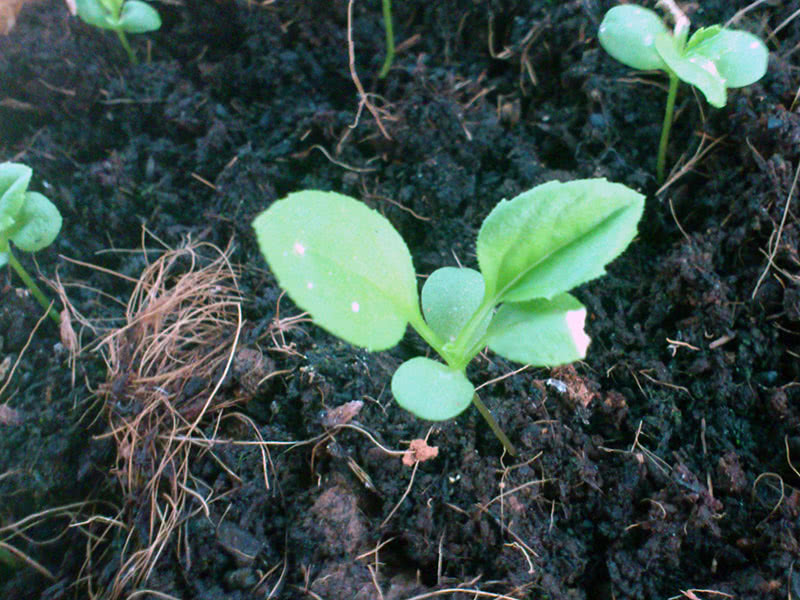
Sowing of asters to get seedlings
Seedling way of aster gowing is much more reliable than non-seedling one, although it requires a little more time and efforts. Seeds are sown in early April or May, depending on the variety. A week before sowing, wrap the aster seeds in a cloth and soak them in a weak solution of potassium permanganate. In 10-12 hours, squeeze the cloth from excess moisture, put it in a plastic bag and place it in a warm place for germination. You can use boxes or pots for growing aster seedlings. The soil for aster should be light and fertile, before planting it is necessary to process it with fungicide solution. Sow germinated seeds in the furrows, sprinkle them with a 0.2 inch layer of sand, pour it with a weak solution of potassium permanganate through a fine sieve, and cover the pot with glass or foil, put it a warm place (68-72ºF). If you sow the last year’s seeds, then the sprouts will be in 3-5 days. When the sprouts appear, place the containers in a cooler room – approximately 61°F. The shoots are pricked out according to 4x4 scheme, when they have 3-4 true leaves. When pricking, shorten the roots of the seedlings. Add some ashe into the soil for transplanting, water the pricked seedlings generously.
Planting of aster
When to plant asters
In a week after pricking, feed the seedlings with a solution of combined fertilizers and continue to feed them once a week until the very planting out in the open ground. Begin gradually hardening them off by taking the seedlings outdoors for a while, as hardened seedlings take root better. By the time of planting, your seedlings should have a sturdy stem up to 4 inches high and 6-8 large green leaves. The best time to plant seedlings is about April-May. Asters are cold-resistant and not afraid of a night temperature drop to 37-39°F. It is better to plant the asters in the open ground in the evening.
How to plant asters
Planting of asters starts with a spot selection. The place for transplanting should be sunny, with good drainage. The most beneficial predecessors for asters are marigolds and calendula. Planting and caring for asters are best performed if the soil is light, fertile, neutral. The place for the planting of asters should be prepared in advance: in autumn dig up deeply the site with adding humus or compost at a rate of 4.4-8.8 pounds / 11 ft², and in spring dig up the site adding 0.7-1.4 oz of superphosphate, 0.5-0.7 oz of potassium salt and the same amount of ammonium sulphate per 11 ft². If the soil on the site is not depleted, there is no need to apply fertilizers.
Before planting, the spot must be weeded, leveled and loosened to a depth of 1.6-2.4 inches. It is also advisable to moisten the soil, especially if the seedlings are bought in the store and you do not know how long their roots have been bare. In shallow watered furrows seedlings are planted 8 inches apart, although the distance depends on the variety of aster. The distance between the furrows is about 20 inches. The seedlings are sprinkled with dry soil, watering after planting is not required, they can be watered only in 2-4 days. After a week or two, feed the asters with nitrogen fertilizers.
Care of aster
How to care for aster
Any experienced florist will answer the question “How to grow asters?” that it is very easy. Asters are minimal-care plants, and caring for them does not require much time and effort. The first rule of care of asters is the obligatory loosening of the soil with the simultaneous weeding. It is necessary to do this after each rain or watering to a depth of 1.6-2.4 inches, no deeper. Before the beginning of branching, earth-up the stem to a height of 2.4-3 inches to promote the growth of the roots.
When watering the asters, remember that both a lack and an excess of moisture hurt them. In a hot summer water them less often, but more generously (up to 3 buckets of water per 11 ft²), with the needed following loosening. If you are late with watering, the inflorescences may lose its beauty.
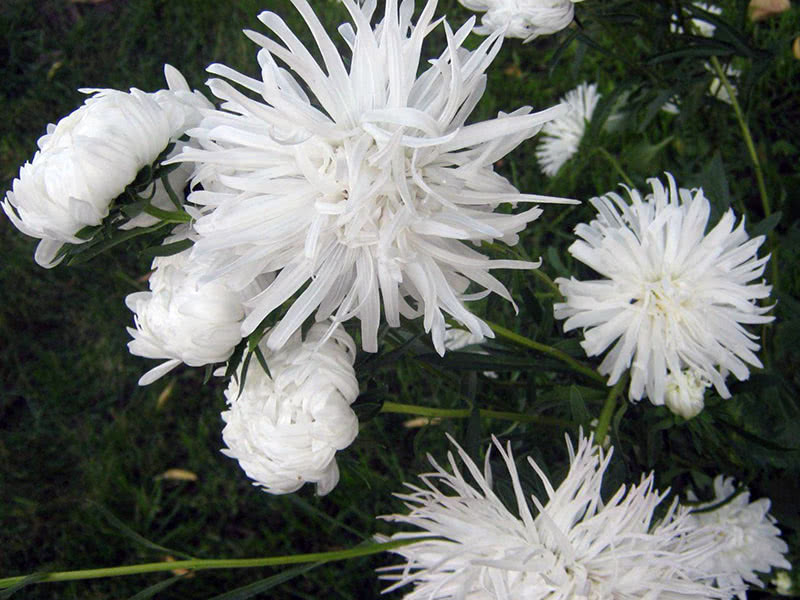
If you want to get the most out of your asters, do not forget to feed them. During the season there should be at least three feedings: the first one is in a week or two after planting (0.7 oz of ammonium nitrate, 0.4 oz of potassium sulfate, 1.7 oz of superphosphate per 11 ft²); when the buds appear you need to feed the asters a second time (1.7 oz of potassium sulfate and superphosphate per 11 ft² ) and the third feeding is carried out with the same substances at the very beginning of flowering.
Timely deadhead the spent flowers.
Possible difficulties in growing of asters
Sometimes easy-to-grow asters make the gardeners nervous, especially if it is your first try to grow these little “stars” on your site.
- Difficulties begin with sowing: seeds do not germinate or seedlings grow poorly and wither. In order not to waste the time, immediately re-sow the seeds, but strictly follow all soil requirements as the reason is its composition or insufficient pre-seed treatment;
- Annual asters are affected by fusarium wilt. Do not plant asters where the Solanaceae (potatoes, tomatoes) or gillyflowers, carnations, gladioli, tulips grew the last years; after that at least five years must pass, otherwise you will put the asters at risk of getting fusariosis; for the same reason, do not fertilize the asters with a fresh manure;
- Asters have incomplete inflorescences – the reason may be that the plant suffers from aphids or spider mite, possibly the gardening rules are not followed or the plant does not get enough supplements.
Diseases of asters
Fusarium wilt is the main and most frequent disease of asters. It is caused by a fungus of the genus Fusarium and manifests itself when the plant is already adult – it suddenly weakens, and one side turns yellow, brown and fades. There are no ways to overcome fusarium wilt, so it is so important to take a preventive measure such as rotation of crops on the site. Alternate aster with other plants so that it gets on the site once in 5 years. The diseased plants must be removed and burned so that the infection does not spread to other plants and spots.
Another fungal disease affecting asters is the black leg that manifests itself by the blackening of the seedling and decay of the root collar and base of the stem. The causative agent of the disease develops in acidic soils. To control the disease, remove the infected plants, disinfection the soil with a 1% solution of potassium permanganate, and mulch the soil around the plant with sand.
Asters suffer from rust – on downside of the leaves there are swellings, in which there are spores, the leaves wither and get dry. Plant asters away from conifers (it is from them the spores of rust fall on the asters), as a preventative measure spray asters with 1% solution of Bordeaux mixture, and if the disease has already manifested itself, then repeat such spraying weekly.
Yellow disease is another disease that affects asters and is caused by a virus that is carried by aphids or cicadas. First, the leaf surface becomes lighter, then there is a general chlorosis of the leaf, the growth is suppressed, buds get damaged and become of a greenish shade. To destroy the carrying agents, you need to spray asters with insecticides (Actellic), and the affected plants must be dug out and burned.
Powdery mildew, verticillium wilt are the diseases that are well cured with fungicides.
Pests of asters
Such insect pests as an European tarnished plant bug, meadow spittlebug, grey field slug, common earwig, spider mites, aphid and cutworm are dangerous for asters. As a preventive measure we offer you:
- a thorough autumn digging-up of the soil in the garden;
- removal and burning of annual plants and perennial shoots dying off by autumn;
- the right approach in the selection of plant varieties for the garden;
- soil improvement by liming and applying of compost and humus;
- keeping of the required distance between plants for them not to grow sick and not to elongate because of thickness.
If the pests have appeared, then they will have to be controlled either with pesticides or with folk remedies. Grey field slug is destroyed either manually (collect by hand and destroy), or by a drug containing metaldehyde; common earwig is controlled by spraying the plants with a fungicide; meadow spittlebug, cutworm, spider mite, European tarnished plant bug are destroyed with a solution of insecticide (malathion, phosphamidum).
Asters have faded – what to do
Asters after flowering
Annual asters after flowering should be dug out and burnt to destroy viruses, fungi and pests that could settle in them. If you collect the seeds of varieties that you want to grow next year, you can sow the seeds in the soil after the first frosts, but in another part of the garden. Sow the seeds in furrows, sprinkle them with peat or humus. Winter planting can be carried out directly in the snow in December-January. For this, the furrows are made directly in the slightly compacted snow, and the seeds are covered with the same peat. Sowing of the seeds in the snow is even safer, because the seeds are not afraid of sudden thaws. In spring, when the snow has melted, cover the spot with a foil to foster the germination of seeds.
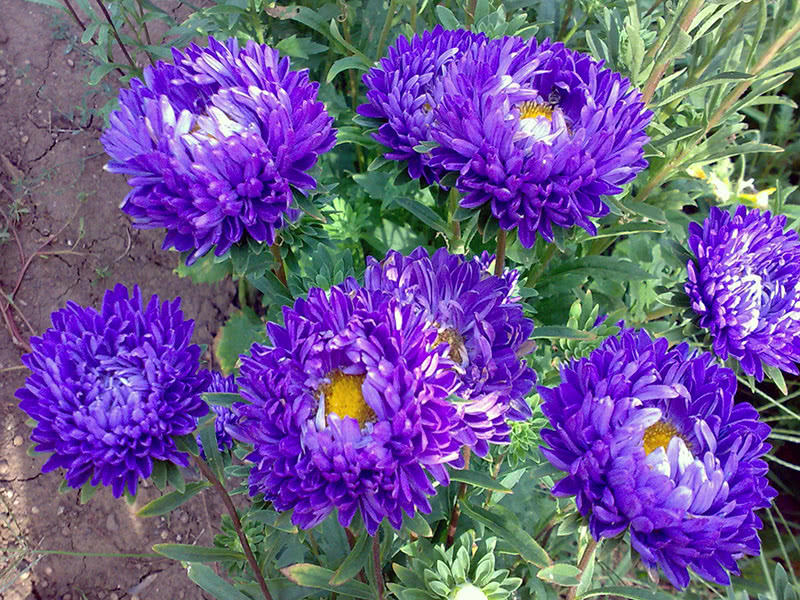
Seeds of asters are collected like this: wait until the inflorescences of the variety you like have faded, its center has darkened and a white fluff has appeared in it, cut off the inflorescence, place it in a paper bag in which it will continue drying. Sign the package not to confuse the varieties. And remember: it's better to sow the last year's seeds to grow seedling or in the soil, because in two years they sharply lose their germination capacity.
How to store asters in winter
Perennial asters can grow on one site for up to five years, so autumn is the time to dig out and plant out perennial asters that have turned 5 years old, especially if they are propagated by bush division. Be careful with the root system, try not to damage it.
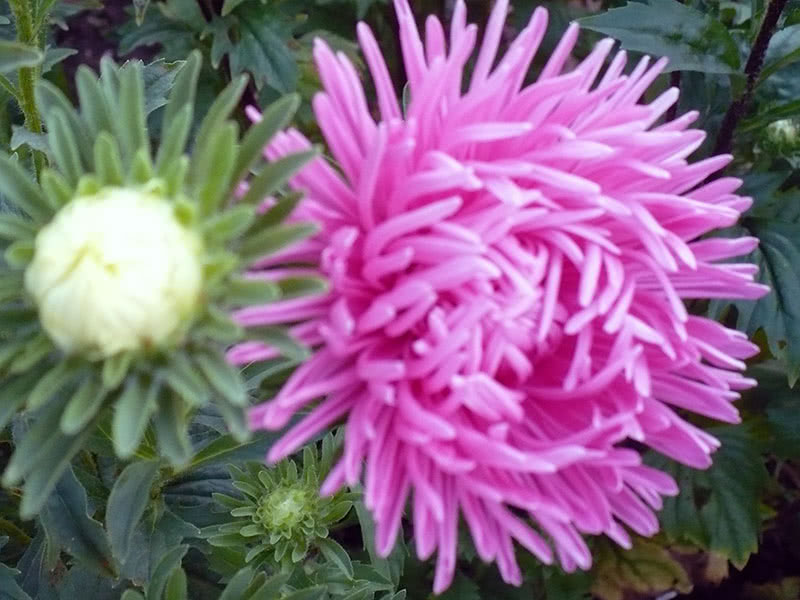
Perennial asters are frost-hardy, so they easily overwinter in the open ground. But there are some varieties young plants of which should be covered with peat, dry leaves or fir twigs in winter. If the stalks of asters are dry, it is better to cut them off before covering. In spring, remove the cover for your asters to start growing as soon as possible and decorate your garden with their unusual flowers.
Twilight is coming. Thin and sharp
Light shimmers in the sky of the constellations.
In the fragrant and molted flower-bed aster
Watches the distant sisters’ shine,
And sends them greetings from the earth.
(Vs. Rozhdestvenskiy)


